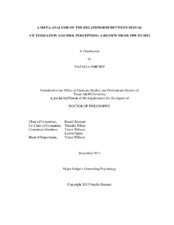| dc.description.abstract | Sexual victimization is a growing problem among women. Sexual victimization can be described as an event where an individual undergoes an unwanted sexual experience. There are many factors that could increase a woman’s risk for sexual victimization. One of the most important factors is risk perception. Risk perception is embedded in the way individuals perceive, interpret, and react to a risky situation. Sexual victimization and risk perception has been an area of focus for many during the past few years. Although, there is a large body of evidence in this area, many of the studies are inconsistent and currently only one literature review exists. Therefore, there is a need for a meta-analysis study to try to understand the sexual victimization and risk perception relationship from a quantitative perspective, as well as to detect the types of moderator variables that may influence it.
This study sought to analyze and synthesize the empirical findings of the relationship between sexual victimization and risk perception from 1990 through March 2013. A secondary goal is to better understand the relationship between sexual victimization and risk perception. A tertiary purpose was to understand the moderating influence of a number of factors on this relationship. Consistent with the guidelines and procedures for a meta-analysis set forth by Cooper in 2010, 51 studies were identified producing a total 116 effect sizes. These effect sizes were not calculated independently. Instead, the effect sizes from each study were averaged in order to form a mean effect size per study. The mean effects were then averaged to form the omnibus mean effect size.
The omnibus mean effect size from the 51 studies was of g = 0.167, p < .001, demonstrating a small-sized effect. This effect size was more modest in magnitude; however, it demonstrated a relationship between sexual victimization and risk perception. All the moderators with the exception of alcohol and design quality were significant contributors to the variance in the effect sizes. In addition to examining the omnibus mean effect size and potential moderators, limitations and implications for practice and future research were discussed. | en |


